Human Resource Management Report: Culture, Teamwork and Control
VerifiedAdded on 2020/01/21
|8
|2074
|52
Report
AI Summary
This report delves into key aspects of Human Resource Management, focusing on organizational culture and teamwork. It explores the extent to which management can control organizational culture, examining various strategies like leadership styles, organizational structure, and reward systems. The report also evaluates the statement of whether teamwork empowers workers or leads to intensified managerial control, analyzing the benefits and potential drawbacks of teamwork in the context of employee empowerment and managerial oversight. The conclusion summarizes the findings, highlighting the interplay between culture, teamwork, and the role of management in shaping employee behavior and achieving organizational goals. The report references several academic sources to support its analysis.
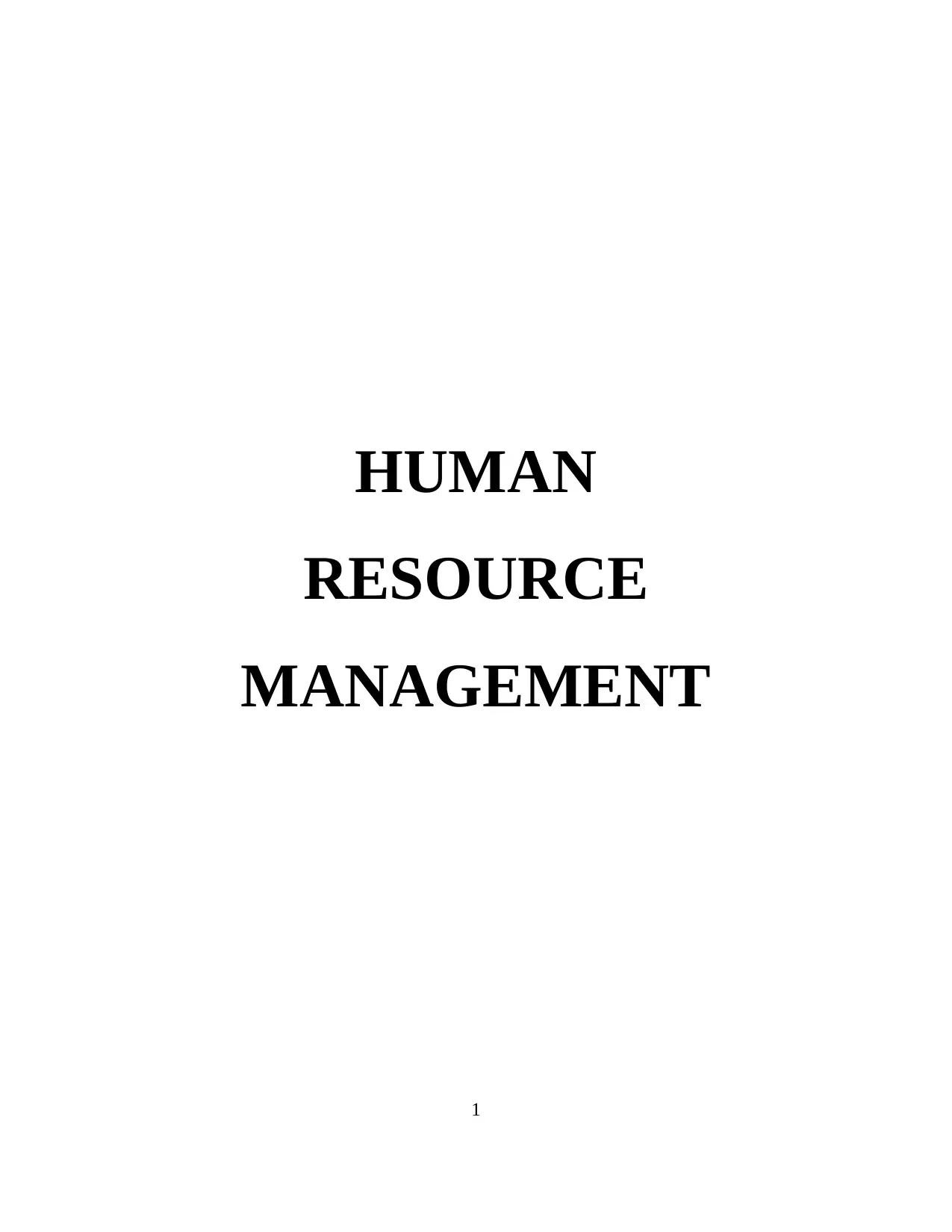
HUMAN
RESOURCE
MANAGEMENT
1
RESOURCE
MANAGEMENT
1
Paraphrase This Document
Need a fresh take? Get an instant paraphrase of this document with our AI Paraphraser
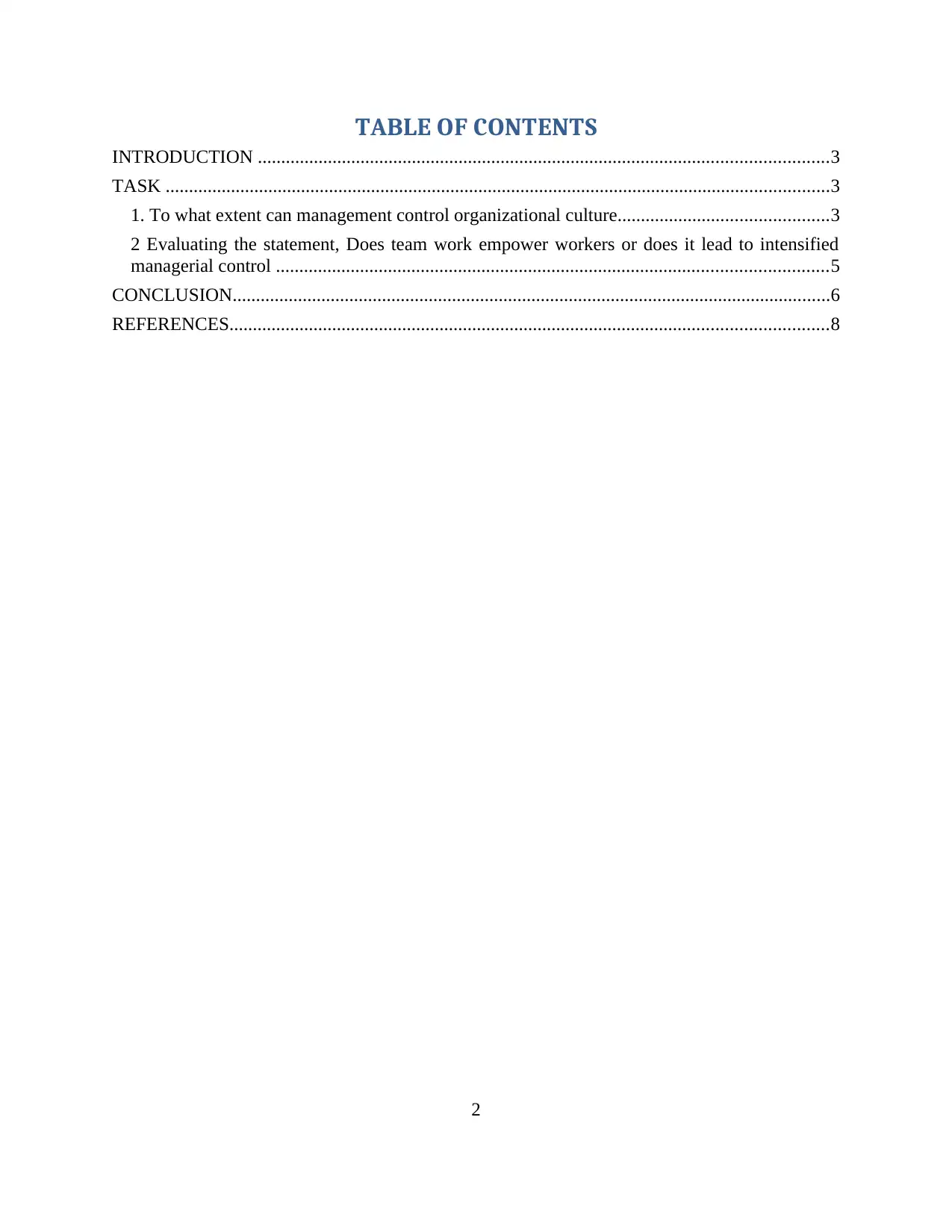
TABLE OF CONTENTS
INTRODUCTION ..........................................................................................................................3
TASK ..............................................................................................................................................3
1. To what extent can management control organizational culture.............................................3
2 Evaluating the statement, Does team work empower workers or does it lead to intensified
managerial control ......................................................................................................................5
CONCLUSION................................................................................................................................6
REFERENCES................................................................................................................................8
2
INTRODUCTION ..........................................................................................................................3
TASK ..............................................................................................................................................3
1. To what extent can management control organizational culture.............................................3
2 Evaluating the statement, Does team work empower workers or does it lead to intensified
managerial control ......................................................................................................................5
CONCLUSION................................................................................................................................6
REFERENCES................................................................................................................................8
2
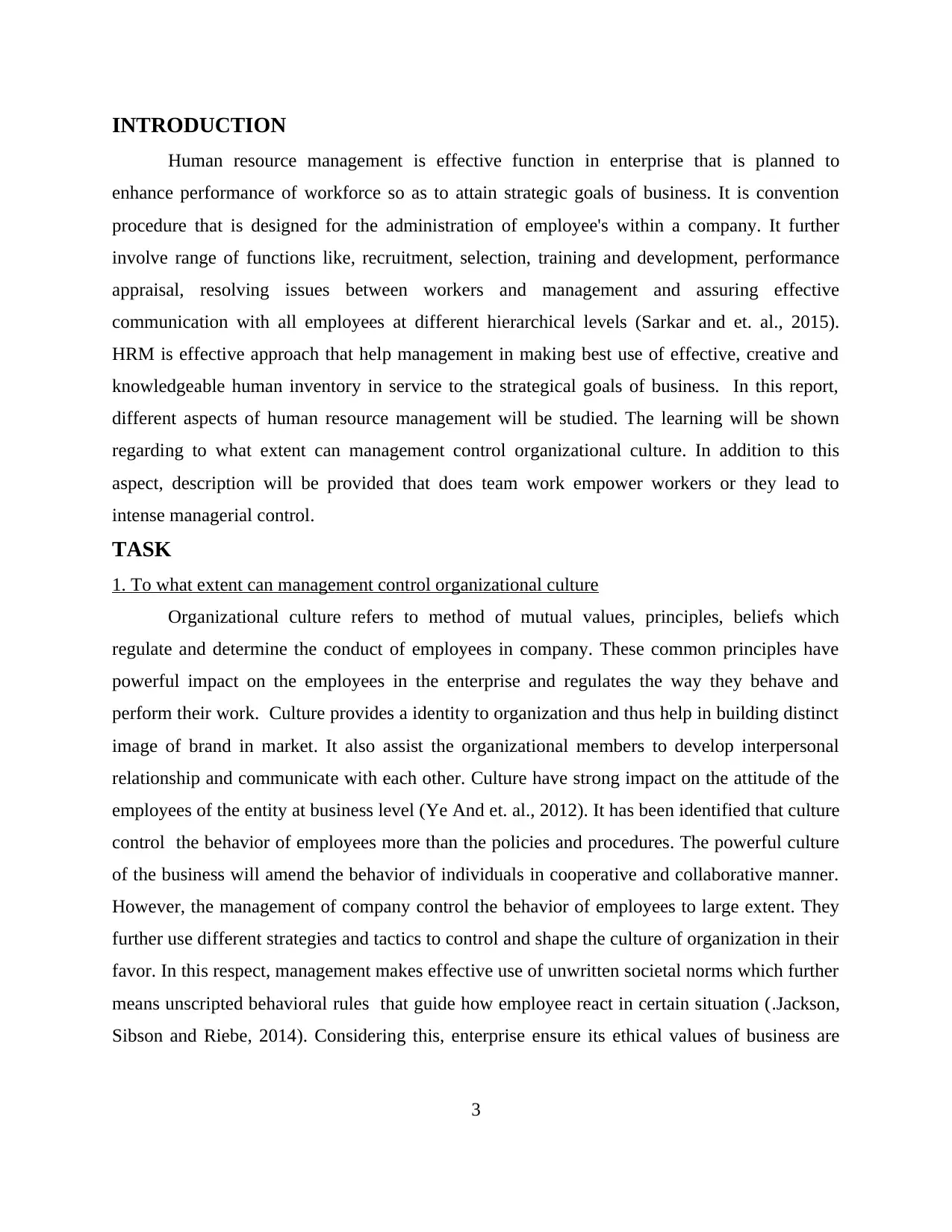
INTRODUCTION
Human resource management is effective function in enterprise that is planned to
enhance performance of workforce so as to attain strategic goals of business. It is convention
procedure that is designed for the administration of employee's within a company. It further
involve range of functions like, recruitment, selection, training and development, performance
appraisal, resolving issues between workers and management and assuring effective
communication with all employees at different hierarchical levels (Sarkar and et. al., 2015).
HRM is effective approach that help management in making best use of effective, creative and
knowledgeable human inventory in service to the strategical goals of business. In this report,
different aspects of human resource management will be studied. The learning will be shown
regarding to what extent can management control organizational culture. In addition to this
aspect, description will be provided that does team work empower workers or they lead to
intense managerial control.
TASK
1. To what extent can management control organizational culture
Organizational culture refers to method of mutual values, principles, beliefs which
regulate and determine the conduct of employees in company. These common principles have
powerful impact on the employees in the enterprise and regulates the way they behave and
perform their work. Culture provides a identity to organization and thus help in building distinct
image of brand in market. It also assist the organizational members to develop interpersonal
relationship and communicate with each other. Culture have strong impact on the attitude of the
employees of the entity at business level (Ye And et. al., 2012). It has been identified that culture
control the behavior of employees more than the policies and procedures. The powerful culture
of the business will amend the behavior of individuals in cooperative and collaborative manner.
However, the management of company control the behavior of employees to large extent. They
further use different strategies and tactics to control and shape the culture of organization in their
favor. In this respect, management makes effective use of unwritten societal norms which further
means unscripted behavioral rules that guide how employee react in certain situation (.Jackson,
Sibson and Riebe, 2014). Considering this, enterprise ensure its ethical values of business are
3
Human resource management is effective function in enterprise that is planned to
enhance performance of workforce so as to attain strategic goals of business. It is convention
procedure that is designed for the administration of employee's within a company. It further
involve range of functions like, recruitment, selection, training and development, performance
appraisal, resolving issues between workers and management and assuring effective
communication with all employees at different hierarchical levels (Sarkar and et. al., 2015).
HRM is effective approach that help management in making best use of effective, creative and
knowledgeable human inventory in service to the strategical goals of business. In this report,
different aspects of human resource management will be studied. The learning will be shown
regarding to what extent can management control organizational culture. In addition to this
aspect, description will be provided that does team work empower workers or they lead to
intense managerial control.
TASK
1. To what extent can management control organizational culture
Organizational culture refers to method of mutual values, principles, beliefs which
regulate and determine the conduct of employees in company. These common principles have
powerful impact on the employees in the enterprise and regulates the way they behave and
perform their work. Culture provides a identity to organization and thus help in building distinct
image of brand in market. It also assist the organizational members to develop interpersonal
relationship and communicate with each other. Culture have strong impact on the attitude of the
employees of the entity at business level (Ye And et. al., 2012). It has been identified that culture
control the behavior of employees more than the policies and procedures. The powerful culture
of the business will amend the behavior of individuals in cooperative and collaborative manner.
However, the management of company control the behavior of employees to large extent. They
further use different strategies and tactics to control and shape the culture of organization in their
favor. In this respect, management makes effective use of unwritten societal norms which further
means unscripted behavioral rules that guide how employee react in certain situation (.Jackson,
Sibson and Riebe, 2014). Considering this, enterprise ensure its ethical values of business are
3
⊘ This is a preview!⊘
Do you want full access?
Subscribe today to unlock all pages.

Trusted by 1+ million students worldwide
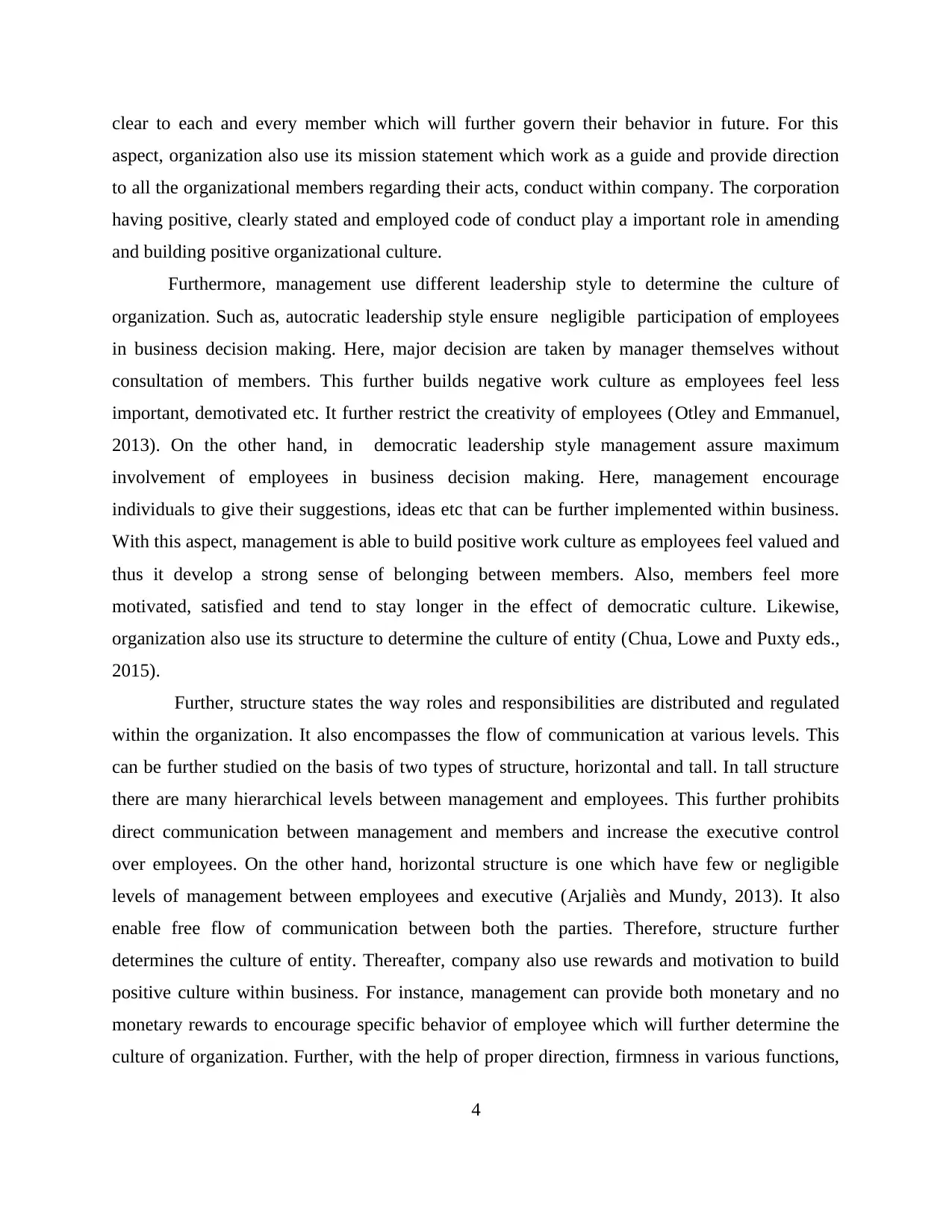
clear to each and every member which will further govern their behavior in future. For this
aspect, organization also use its mission statement which work as a guide and provide direction
to all the organizational members regarding their acts, conduct within company. The corporation
having positive, clearly stated and employed code of conduct play a important role in amending
and building positive organizational culture.
Furthermore, management use different leadership style to determine the culture of
organization. Such as, autocratic leadership style ensure negligible participation of employees
in business decision making. Here, major decision are taken by manager themselves without
consultation of members. This further builds negative work culture as employees feel less
important, demotivated etc. It further restrict the creativity of employees (Otley and Emmanuel,
2013). On the other hand, in democratic leadership style management assure maximum
involvement of employees in business decision making. Here, management encourage
individuals to give their suggestions, ideas etc that can be further implemented within business.
With this aspect, management is able to build positive work culture as employees feel valued and
thus it develop a strong sense of belonging between members. Also, members feel more
motivated, satisfied and tend to stay longer in the effect of democratic culture. Likewise,
organization also use its structure to determine the culture of entity (Chua, Lowe and Puxty eds.,
2015).
Further, structure states the way roles and responsibilities are distributed and regulated
within the organization. It also encompasses the flow of communication at various levels. This
can be further studied on the basis of two types of structure, horizontal and tall. In tall structure
there are many hierarchical levels between management and employees. This further prohibits
direct communication between management and members and increase the executive control
over employees. On the other hand, horizontal structure is one which have few or negligible
levels of management between employees and executive (Arjaliès and Mundy, 2013). It also
enable free flow of communication between both the parties. Therefore, structure further
determines the culture of entity. Thereafter, company also use rewards and motivation to build
positive culture within business. For instance, management can provide both monetary and no
monetary rewards to encourage specific behavior of employee which will further determine the
culture of organization. Further, with the help of proper direction, firmness in various functions,
4
aspect, organization also use its mission statement which work as a guide and provide direction
to all the organizational members regarding their acts, conduct within company. The corporation
having positive, clearly stated and employed code of conduct play a important role in amending
and building positive organizational culture.
Furthermore, management use different leadership style to determine the culture of
organization. Such as, autocratic leadership style ensure negligible participation of employees
in business decision making. Here, major decision are taken by manager themselves without
consultation of members. This further builds negative work culture as employees feel less
important, demotivated etc. It further restrict the creativity of employees (Otley and Emmanuel,
2013). On the other hand, in democratic leadership style management assure maximum
involvement of employees in business decision making. Here, management encourage
individuals to give their suggestions, ideas etc that can be further implemented within business.
With this aspect, management is able to build positive work culture as employees feel valued and
thus it develop a strong sense of belonging between members. Also, members feel more
motivated, satisfied and tend to stay longer in the effect of democratic culture. Likewise,
organization also use its structure to determine the culture of entity (Chua, Lowe and Puxty eds.,
2015).
Further, structure states the way roles and responsibilities are distributed and regulated
within the organization. It also encompasses the flow of communication at various levels. This
can be further studied on the basis of two types of structure, horizontal and tall. In tall structure
there are many hierarchical levels between management and employees. This further prohibits
direct communication between management and members and increase the executive control
over employees. On the other hand, horizontal structure is one which have few or negligible
levels of management between employees and executive (Arjaliès and Mundy, 2013). It also
enable free flow of communication between both the parties. Therefore, structure further
determines the culture of entity. Thereafter, company also use rewards and motivation to build
positive culture within business. For instance, management can provide both monetary and no
monetary rewards to encourage specific behavior of employee which will further determine the
culture of organization. Further, with the help of proper direction, firmness in various functions,
4
Paraphrase This Document
Need a fresh take? Get an instant paraphrase of this document with our AI Paraphraser
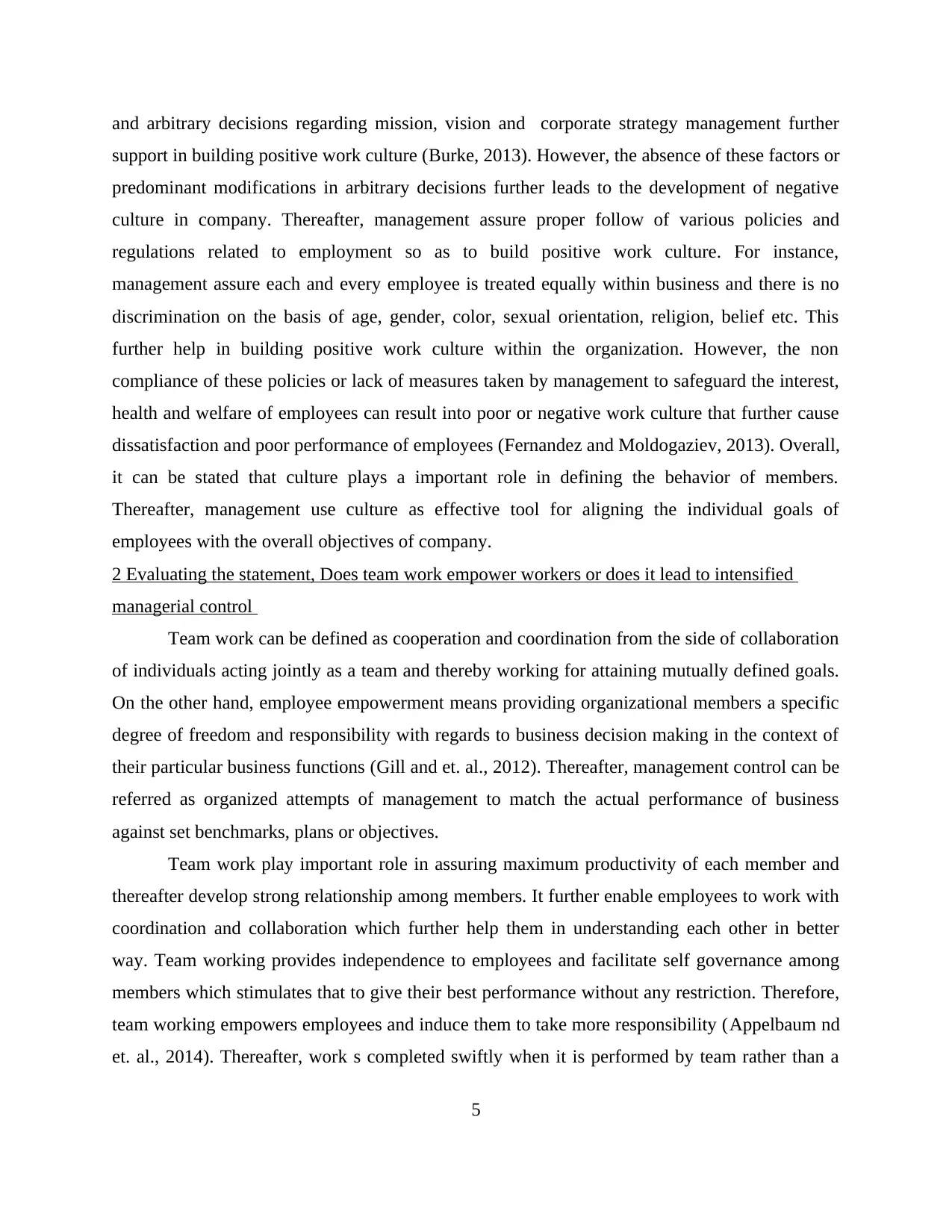
and arbitrary decisions regarding mission, vision and corporate strategy management further
support in building positive work culture (Burke, 2013). However, the absence of these factors or
predominant modifications in arbitrary decisions further leads to the development of negative
culture in company. Thereafter, management assure proper follow of various policies and
regulations related to employment so as to build positive work culture. For instance,
management assure each and every employee is treated equally within business and there is no
discrimination on the basis of age, gender, color, sexual orientation, religion, belief etc. This
further help in building positive work culture within the organization. However, the non
compliance of these policies or lack of measures taken by management to safeguard the interest,
health and welfare of employees can result into poor or negative work culture that further cause
dissatisfaction and poor performance of employees (Fernandez and Moldogaziev, 2013). Overall,
it can be stated that culture plays a important role in defining the behavior of members.
Thereafter, management use culture as effective tool for aligning the individual goals of
employees with the overall objectives of company.
2 Evaluating the statement, Does team work empower workers or does it lead to intensified
managerial control
Team work can be defined as cooperation and coordination from the side of collaboration
of individuals acting jointly as a team and thereby working for attaining mutually defined goals.
On the other hand, employee empowerment means providing organizational members a specific
degree of freedom and responsibility with regards to business decision making in the context of
their particular business functions (Gill and et. al., 2012). Thereafter, management control can be
referred as organized attempts of management to match the actual performance of business
against set benchmarks, plans or objectives.
Team work play important role in assuring maximum productivity of each member and
thereafter develop strong relationship among members. It further enable employees to work with
coordination and collaboration which further help them in understanding each other in better
way. Team working provides independence to employees and facilitate self governance among
members which stimulates that to give their best performance without any restriction. Therefore,
team working empowers employees and induce them to take more responsibility (Appelbaum nd
et. al., 2014). Thereafter, work s completed swiftly when it is performed by team rather than a
5
support in building positive work culture (Burke, 2013). However, the absence of these factors or
predominant modifications in arbitrary decisions further leads to the development of negative
culture in company. Thereafter, management assure proper follow of various policies and
regulations related to employment so as to build positive work culture. For instance,
management assure each and every employee is treated equally within business and there is no
discrimination on the basis of age, gender, color, sexual orientation, religion, belief etc. This
further help in building positive work culture within the organization. However, the non
compliance of these policies or lack of measures taken by management to safeguard the interest,
health and welfare of employees can result into poor or negative work culture that further cause
dissatisfaction and poor performance of employees (Fernandez and Moldogaziev, 2013). Overall,
it can be stated that culture plays a important role in defining the behavior of members.
Thereafter, management use culture as effective tool for aligning the individual goals of
employees with the overall objectives of company.
2 Evaluating the statement, Does team work empower workers or does it lead to intensified
managerial control
Team work can be defined as cooperation and coordination from the side of collaboration
of individuals acting jointly as a team and thereby working for attaining mutually defined goals.
On the other hand, employee empowerment means providing organizational members a specific
degree of freedom and responsibility with regards to business decision making in the context of
their particular business functions (Gill and et. al., 2012). Thereafter, management control can be
referred as organized attempts of management to match the actual performance of business
against set benchmarks, plans or objectives.
Team work play important role in assuring maximum productivity of each member and
thereafter develop strong relationship among members. It further enable employees to work with
coordination and collaboration which further help them in understanding each other in better
way. Team working provides independence to employees and facilitate self governance among
members which stimulates that to give their best performance without any restriction. Therefore,
team working empowers employees and induce them to take more responsibility (Appelbaum nd
et. al., 2014). Thereafter, work s completed swiftly when it is performed by team rather than a
5
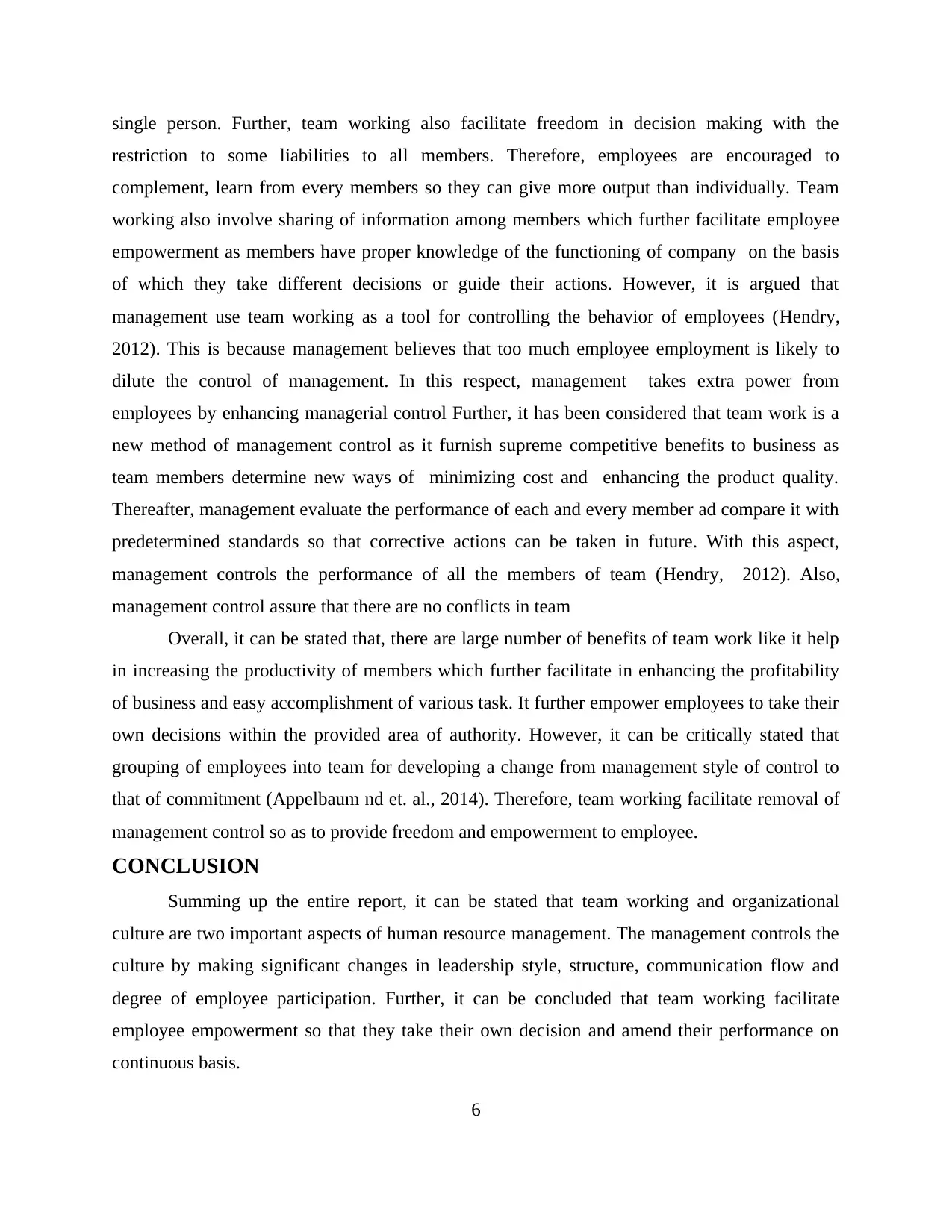
single person. Further, team working also facilitate freedom in decision making with the
restriction to some liabilities to all members. Therefore, employees are encouraged to
complement, learn from every members so they can give more output than individually. Team
working also involve sharing of information among members which further facilitate employee
empowerment as members have proper knowledge of the functioning of company on the basis
of which they take different decisions or guide their actions. However, it is argued that
management use team working as a tool for controlling the behavior of employees (Hendry,
2012). This is because management believes that too much employee employment is likely to
dilute the control of management. In this respect, management takes extra power from
employees by enhancing managerial control Further, it has been considered that team work is a
new method of management control as it furnish supreme competitive benefits to business as
team members determine new ways of minimizing cost and enhancing the product quality.
Thereafter, management evaluate the performance of each and every member ad compare it with
predetermined standards so that corrective actions can be taken in future. With this aspect,
management controls the performance of all the members of team (Hendry, 2012). Also,
management control assure that there are no conflicts in team
Overall, it can be stated that, there are large number of benefits of team work like it help
in increasing the productivity of members which further facilitate in enhancing the profitability
of business and easy accomplishment of various task. It further empower employees to take their
own decisions within the provided area of authority. However, it can be critically stated that
grouping of employees into team for developing a change from management style of control to
that of commitment (Appelbaum nd et. al., 2014). Therefore, team working facilitate removal of
management control so as to provide freedom and empowerment to employee.
CONCLUSION
Summing up the entire report, it can be stated that team working and organizational
culture are two important aspects of human resource management. The management controls the
culture by making significant changes in leadership style, structure, communication flow and
degree of employee participation. Further, it can be concluded that team working facilitate
employee empowerment so that they take their own decision and amend their performance on
continuous basis.
6
restriction to some liabilities to all members. Therefore, employees are encouraged to
complement, learn from every members so they can give more output than individually. Team
working also involve sharing of information among members which further facilitate employee
empowerment as members have proper knowledge of the functioning of company on the basis
of which they take different decisions or guide their actions. However, it is argued that
management use team working as a tool for controlling the behavior of employees (Hendry,
2012). This is because management believes that too much employee employment is likely to
dilute the control of management. In this respect, management takes extra power from
employees by enhancing managerial control Further, it has been considered that team work is a
new method of management control as it furnish supreme competitive benefits to business as
team members determine new ways of minimizing cost and enhancing the product quality.
Thereafter, management evaluate the performance of each and every member ad compare it with
predetermined standards so that corrective actions can be taken in future. With this aspect,
management controls the performance of all the members of team (Hendry, 2012). Also,
management control assure that there are no conflicts in team
Overall, it can be stated that, there are large number of benefits of team work like it help
in increasing the productivity of members which further facilitate in enhancing the profitability
of business and easy accomplishment of various task. It further empower employees to take their
own decisions within the provided area of authority. However, it can be critically stated that
grouping of employees into team for developing a change from management style of control to
that of commitment (Appelbaum nd et. al., 2014). Therefore, team working facilitate removal of
management control so as to provide freedom and empowerment to employee.
CONCLUSION
Summing up the entire report, it can be stated that team working and organizational
culture are two important aspects of human resource management. The management controls the
culture by making significant changes in leadership style, structure, communication flow and
degree of employee participation. Further, it can be concluded that team working facilitate
employee empowerment so that they take their own decision and amend their performance on
continuous basis.
6
⊘ This is a preview!⊘
Do you want full access?
Subscribe today to unlock all pages.

Trusted by 1+ million students worldwide

7
Paraphrase This Document
Need a fresh take? Get an instant paraphrase of this document with our AI Paraphraser
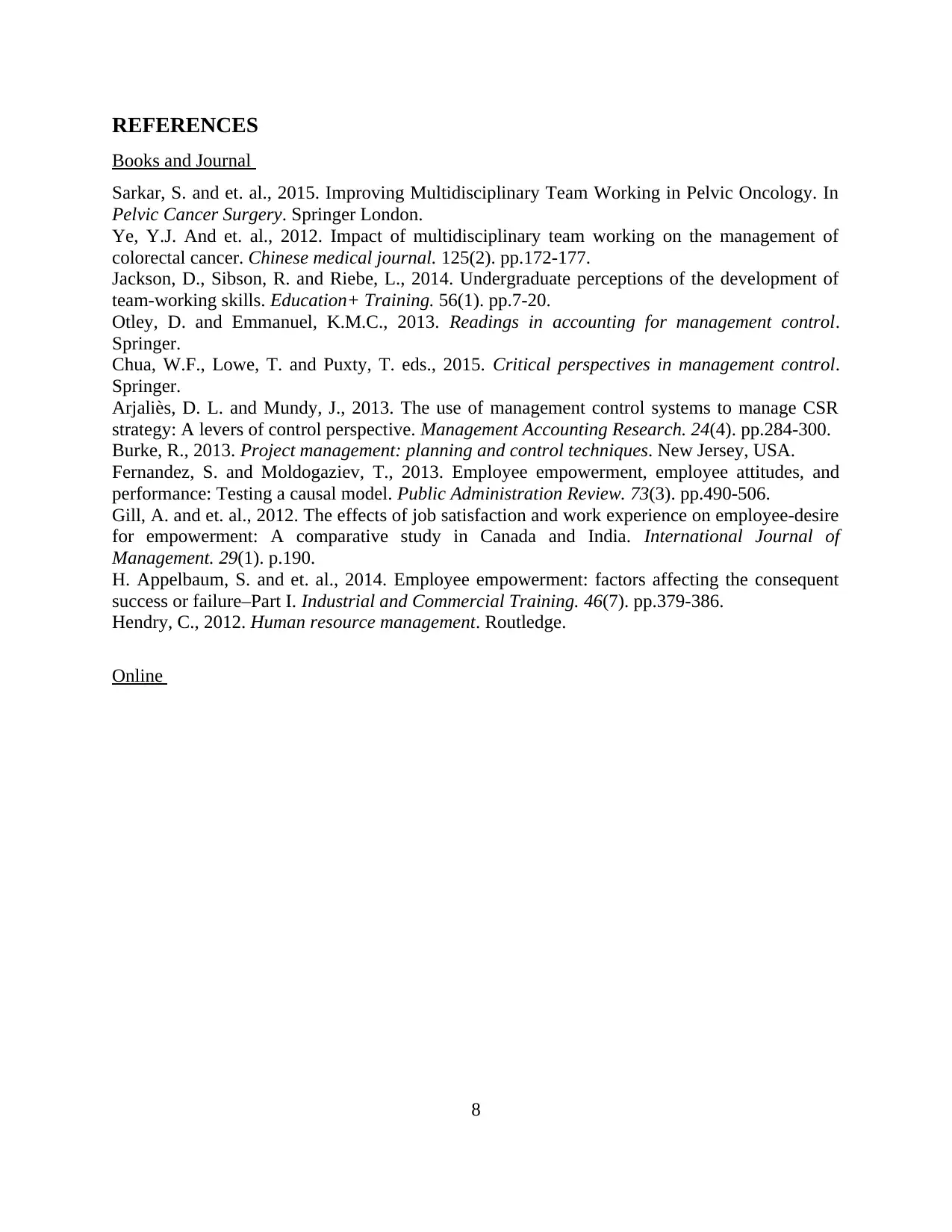
REFERENCES
Books and Journal
Sarkar, S. and et. al., 2015. Improving Multidisciplinary Team Working in Pelvic Oncology. In
Pelvic Cancer Surgery. Springer London.
Ye, Y.J. And et. al., 2012. Impact of multidisciplinary team working on the management of
colorectal cancer. Chinese medical journal. 125(2). pp.172-177.
Jackson, D., Sibson, R. and Riebe, L., 2014. Undergraduate perceptions of the development of
team-working skills. Education+ Training. 56(1). pp.7-20.
Otley, D. and Emmanuel, K.M.C., 2013. Readings in accounting for management control.
Springer.
Chua, W.F., Lowe, T. and Puxty, T. eds., 2015. Critical perspectives in management control.
Springer.
Arjaliès, D. L. and Mundy, J., 2013. The use of management control systems to manage CSR
strategy: A levers of control perspective. Management Accounting Research. 24(4). pp.284-300.
Burke, R., 2013. Project management: planning and control techniques. New Jersey, USA.
Fernandez, S. and Moldogaziev, T., 2013. Employee empowerment, employee attitudes, and
performance: Testing a causal model. Public Administration Review. 73(3). pp.490-506.
Gill, A. and et. al., 2012. The effects of job satisfaction and work experience on employee-desire
for empowerment: A comparative study in Canada and India. International Journal of
Management. 29(1). p.190.
H. Appelbaum, S. and et. al., 2014. Employee empowerment: factors affecting the consequent
success or failure–Part I. Industrial and Commercial Training. 46(7). pp.379-386.
Hendry, C., 2012. Human resource management. Routledge.
Online
8
Books and Journal
Sarkar, S. and et. al., 2015. Improving Multidisciplinary Team Working in Pelvic Oncology. In
Pelvic Cancer Surgery. Springer London.
Ye, Y.J. And et. al., 2012. Impact of multidisciplinary team working on the management of
colorectal cancer. Chinese medical journal. 125(2). pp.172-177.
Jackson, D., Sibson, R. and Riebe, L., 2014. Undergraduate perceptions of the development of
team-working skills. Education+ Training. 56(1). pp.7-20.
Otley, D. and Emmanuel, K.M.C., 2013. Readings in accounting for management control.
Springer.
Chua, W.F., Lowe, T. and Puxty, T. eds., 2015. Critical perspectives in management control.
Springer.
Arjaliès, D. L. and Mundy, J., 2013. The use of management control systems to manage CSR
strategy: A levers of control perspective. Management Accounting Research. 24(4). pp.284-300.
Burke, R., 2013. Project management: planning and control techniques. New Jersey, USA.
Fernandez, S. and Moldogaziev, T., 2013. Employee empowerment, employee attitudes, and
performance: Testing a causal model. Public Administration Review. 73(3). pp.490-506.
Gill, A. and et. al., 2012. The effects of job satisfaction and work experience on employee-desire
for empowerment: A comparative study in Canada and India. International Journal of
Management. 29(1). p.190.
H. Appelbaum, S. and et. al., 2014. Employee empowerment: factors affecting the consequent
success or failure–Part I. Industrial and Commercial Training. 46(7). pp.379-386.
Hendry, C., 2012. Human resource management. Routledge.
Online
8
1 out of 8
Related Documents
Your All-in-One AI-Powered Toolkit for Academic Success.
+13062052269
info@desklib.com
Available 24*7 on WhatsApp / Email
![[object Object]](/_next/static/media/star-bottom.7253800d.svg)
Unlock your academic potential
Copyright © 2020–2025 A2Z Services. All Rights Reserved. Developed and managed by ZUCOL.




